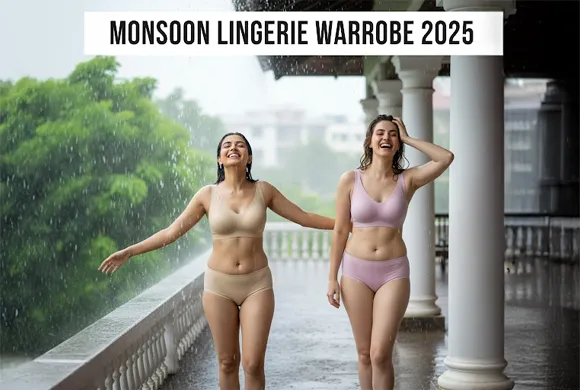The monsoon used to mean a gentle cooling period, but in 2025, it means something else entirely: extreme, persistent humidity and endless dampness. This isn't just about umbrellas and muddy shoes anymore—it’s about your health, comfort and the inner layers you depend on every day.
According to dermatologists, the rainy season causes increased sweat, moisture-trapping and fungal and bacterial infections. That’s why your lingerie wardrobe needs a smart upgrade, moving from fashion to functional health technology.
The monsoon lingerie wardrobe 2025 focuses on quick-dry fabrics, anti-microbial finishes and seamless construction to prevent VPL and underwear chafing during the humid rainy weather. This upgrade is essential, as dermatologists confirm that trapped moisture can increase the risk of infections by nearly 30%.
Here is your complete guide to building a monsoon lingerie wardrobe that will shield you from the toughest monsoon and tell you exactly how to pair them with your everyday Indian outfits.
The 2025 Monsoon Problem: Why Damp Lingerie is a Health Risk

The biggest health threat during the Indian monsoon is not the rain itself, but the environment it creates: perpetually warm and humid.
The New Hygiene Challenge: Fungal Infections & Rashes
Dermatologists report a significant spike in monsoon-related skin conditions every year. The primary culprits are Tinea Cruris (Jock Itch) and Candidiasis (Yeast Infections).
The Root Cause: Traditional innerwear, like thick pure cotton or heavy foam padding, acts like a sponge. It absorbs sweat and humidity but takes hours—sometimes days—to dry completely in a poorly ventilated room. This damp, warm fabric environment is the perfect breeding ground for bacteria and fungi.
The 2025 Solution: You need fabrics that are designed to actively reject moisture and kill microbes, ensuring your intimate wear stays dry, even when the air around you is saturated.
Quick Dry Lingerie Fabrics You Need
The core of your monsoon lingerie wardrobe should be built on advanced, functional fabrics that prioritise quick evaporation and hygiene. This is where lingerie moves from being a simple garment to being essential health technology.
Also Read: Best Fabrics Options for Women’s Panties
1. Choose Moisture-Wicking Microfibre Blends

Use the everyday bras and panties that are typically made of polyamide, nylon, and elastane. These materials are your quick-dry champions for the 2025 monsoon.
Unlike cotton, which absorbs and holds water, these synthetic blends are engineered to actively pull moisture away from the skin and spread it across the fabric surface for rapid evaporation. This process ensures your intimate areas stay dry, significantly reducing the stickiness and friction that leads to chafing and discomfort.
2. Look for Modal Blends
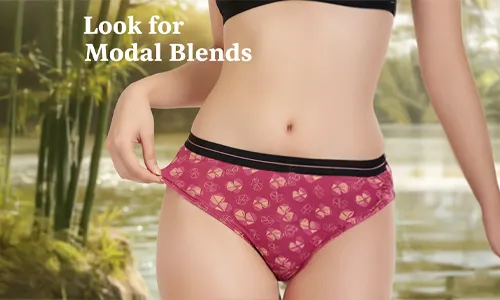
If you prefer a softer, more natural touch against your skin, modal and viscose fabrics offer the superior breathability you seek, and dry significantly faster than pure cotton. They feel cool and light on the skin, effectively reducing the uncomfortable stickiness that is common in high humidity, making them a great choice for all-day comfort, especially for those with sensitive skin.
Also Read: Cotton Panties VS Modal Panties
3. Check for Anti-Microbial Finishes

For bras and everyday innerwear, look for a garment with an anti-microbial finish. This feature is now critical for monsoon hygiene. Many quick-dry fabrics now incorporate finishes, often infused with silver or copper ions, that actively kill the bacteria and fungi responsible for odour and infection before they even have a chance to multiply in the warm, humid environment.
Why Seamless Lingerie is a Must?
Monsoon showers cause outer fabrics like chiffons, georgettes and synthetic kurtas to cling and become slightly sheer against the body. This makes Visible Panty Lines (VPL) and bulky bra seams a major style disaster, especially when you're caught in a sudden downpour. The solution lies entirely in choosing seamless lingerie and specific skin-toned pieces that disappear under clothing.
Go for Laser-Cut Panties
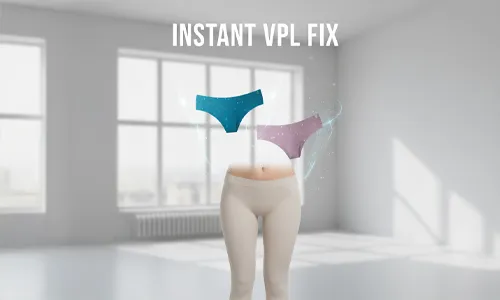
Panties with bonded edges and laser-cut or free-cut edges allow the fabric to lie completely flat and smooth. They literally disappear under any damp or thin fabric, solving the VPL issue instantly and ensuring a smooth silhouette under your outerwear like Salwar suits, fitted trousers, or Georgette kurtas.
Also Read: Seamless Panties vs Regular Panties
Seamless/Moulded Bra Cups in Skin Tones

A seamless or moulded cup bra is essential to prevent texture from showing under sheer tops. Crucially, a shade that matches your skin tone rather than beige shades remains invisible even if your outfit gets wet and transparent.
Also Read: Best Outfits to Pair with a Seamless Bra
Choose Shapewear Made of Anti-Chafing Materials
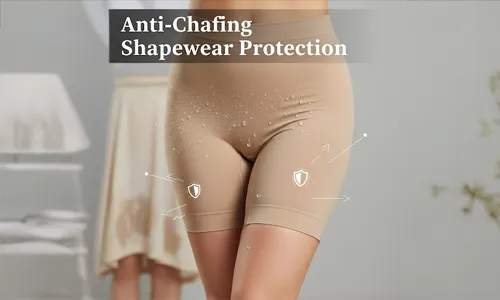
Shapewear is used for everything from tummy-tuckers to thigh shapers under daily wear, but in the monsoon, its function shifts to anti-chafing protection. Traditional cotton slips, saree petticoats, or heavy shapewear fabric hold water and can cause severe, painful chafing when damp.
The fix is to choose high-compression lycra or polyamide blends. The synthetic weave is naturally water-repellent, meaning it absorbs minimal moisture. This material is excellent for both saree shapers and everyday brief/thigh shapers, as its smooth, seamless structure is a crucial barrier against inner thigh friction.
Shift to Period Panties On Those Days
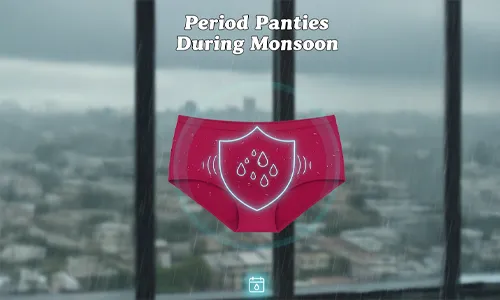
Modern period underwear is essential for managing your cycle during the unpredictable rainy season. While their primary function is leak protection, they must also be seamless to work under fitted clothing. They use layered, technical fabric that remains slim and smooth, avoiding the bulk and visible lines of traditional pads. This offers the ultimate assurance: leak protection, anti-odour and quick-dry functionality, all with a seamless, invisible construction for daily wear.
Also Read: Is it Safe to Wear Period Panties Everyday?
Best 2025 Monsoon Lingerie Styling Tips for Indian Women

So far, we've understood which quick-dry, antimicrobial fabrics to prioritise and why seamless technology is essential for fighting dampness and chafing. Now, it's time to put that knowledge into action!
Below are a few expert styling tips to help you build your monsoon lingerie wardrobe 2025 based on your typical Indian outfits:
For a Light Kurti + Straight Pants Outfit: Pair a seamless T-shirt bra (in your skin tone) with laser-cut panties. The combination ensures zero lines and a completely smooth silhouette.
For a Saree: Choose high-compression, quick-dry shapewear under your saree for smooth draping and protection against chafing. Pair this with a supportive but breathable bra with minimal seams to ensure the look is sleek and lump-free.
For Casual Wear Jeans/Dresses: Focus on anti-microbial panties for all-day hygiene, especially on humid days. If wearing a light cotton dress, always use a seamless/moulded bra to ensure the texture doesn’t show through when the fabric gets damp.
For Working from Home or Errands: Go for a soft bralette (in Modal or Bamboo) under a loose top, paired with a comfy lounge pant made of quick-dry, breathable elastane blends.
For Gym or Indoor Workout: Always use a high-tech sports bra with mesh panels for targeted ventilation and a quick-dry bottom (like Polyamide or Microfiber) that actively wicks moisture away from the skin.
The Colour Code: Avoid white and light colours as they turn near-sheer when wet. Stick to skin tones and dark hues like black, navy and maroon, as they hide water spots and reduce transparency.
Final Thoughts
Ultimately, the best monsoon lingerie wardrobe should contain these three pillars of readiness: quick dry technology to manage the dampness; anti-microbial finishes for superior hygiene; and seamless construction for style confidence. By making these smart, functional choices, you ensure that whatever the rain brings, your comfort and flawless style remain perfectly intact.

